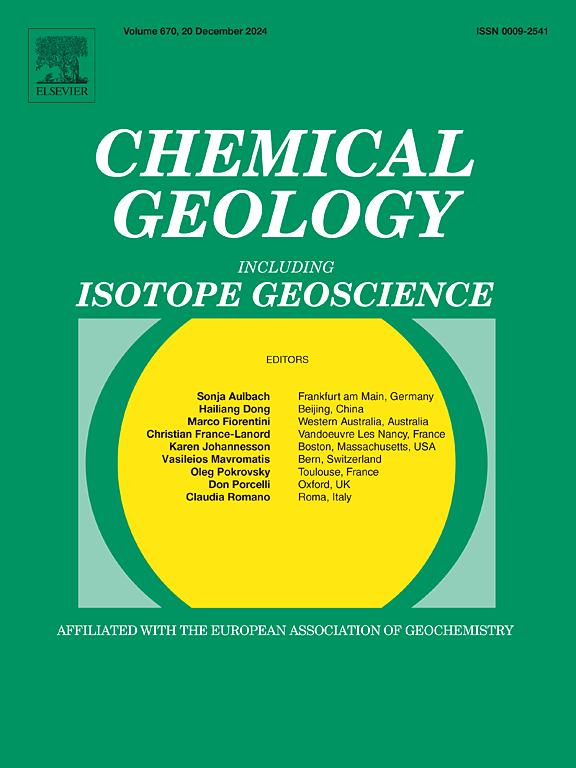Spatial and temporal heterogeneity of the marine nitrogen cycle during the end-Triassic mass extinction
IF 3.6
2区 地球科学
Q1 GEOCHEMISTRY & GEOPHYSICS
引用次数: 0
Abstract
The end-Triassic mass extinction (ETME) marks a pivotal event in Earth's history, characterized by major environmental changes in both marine and terrestrial settings and significant perturbations in the carbon and nitrogen biogeochemical cycles alongside extinction events. Here we employ high-resolution organic carbon isotopes (δ13Corg), nitrogen isotopes from bulk samples (δ15Nbulk), total organic carbon (TOC) and nitrogen content (TN), complemented by carbon (δ13Ckerogen) and nitrogen isotopes (δ15Nkerogen) of kerogen extracts from the Kuhjoch section in Austria in order to investigate the interplay between marine redox state, nitrogen cycling, and the biotic crisis across the Triassic–Jurassic boundary. Our results reveal a significant positive shift (∼3 ‰) in δ15Nbulk values, indicating a perturbed marine nitrogen cycle and expansion of the oxygen minimum zone prior to the ETME. The δ15N profiles suggest a transition from a nitrate-limited ocean dominated by nitrogen fixation to a post-extinction ocean with increased proportion of assimilation of NO3− undergoing non-quantitative denitrification. We also examine the spatial and temporal heterogeneity of the marine nitrogen cycle from different paleoenvironmental settings across the Triassic–Jurassic transition. Bioavailable nitrogen (NO3− and NH4+) limitation prevailed at some localities before and during the ETME. However, the development of N limitation was not synchronous across different locations: it emerged before the ETME in some European basins and intensified after the ETME on Panthalassan shelves. The early Hettangian saw an expansion of euxinic waters into the photic zone and shoaling of the chemocline. Enhanced continental weathering and deep-water upwelling increased nutrient supply, thereby alleviating N limitation. Our new observations point to an unstable and stratified marine environment during the Triassic–Jurassic transition, and suggest that nitrogen bioavailability and redox conditions may be key factors for the devastation of marine ecosystems.
三叠纪末大灭绝时期海洋氮循环的时空异质性
三叠纪末生物大灭绝(ETME)标志着地球历史上的一个关键事件,其特征是海洋和陆地环境发生了重大变化,碳和氮生物地球化学循环在灭绝事件中受到了重大干扰。本文采用高分辨率有机碳同位素(δ13Corg)、大量样品的氮同位素(δ15Nbulk)、总有机碳(TOC)和氮含量(TN),并结合奥地利Kuhjoch剖面干酪根提取物的碳(δ13Ckerogen)和氮同位素(δ15Nkerogen),研究了三叠纪-侏罗纪边界海洋氧化还原状态、氮循环和生物危机之间的相互作用。我们的研究结果显示,δ15Nbulk值显著正移(~ 3‰),表明在ETME之前,海洋氮循环受到干扰,氧最小带扩大。δ15N剖面表明,从一个以固氮为主的硝酸盐限制海洋过渡到一个灭绝后的海洋,NO3−同化比例增加,进行非定量反硝化。我们还研究了三叠纪-侏罗纪过渡时期不同古环境背景下海洋氮循环的时空异质性。生物有效氮(NO3−和NH4+)限制在一些地区在ETME之前和期间普遍存在。然而,N限制在不同地区的发展并非同步的,在欧洲一些盆地出现在ETME之前,在泛海大陆架上出现在ETME之后。河唐纪早期,富氧水向光区扩展,趋化层逐渐浅化。增强的大陆风化和深水上涌增加了养分供应,从而缓解了氮的限制。我们的新观测表明,在三叠纪-侏罗纪过渡时期,海洋环境不稳定且分层,并表明氮的生物有效性和氧化还原条件可能是海洋生态系统破坏的关键因素。
本文章由计算机程序翻译,如有差异,请以英文原文为准。
求助全文
约1分钟内获得全文
求助全文
来源期刊

Chemical Geology
地学-地球化学与地球物理
CiteScore
7.20
自引率
10.30%
发文量
374
审稿时长
3.6 months
期刊介绍:
Chemical Geology is an international journal that publishes original research papers on isotopic and elemental geochemistry, geochronology and cosmochemistry.
The Journal focuses on chemical processes in igneous, metamorphic, and sedimentary petrology, low- and high-temperature aqueous solutions, biogeochemistry, the environment and cosmochemistry.
Papers that are field, experimentally, or computationally based are appropriate if they are of broad international interest. The Journal generally does not publish papers that are primarily of regional or local interest, or which are primarily focused on remediation and applied geochemistry.
The Journal also welcomes innovative papers dealing with significant analytical advances that are of wide interest in the community and extend significantly beyond the scope of what would be included in the methods section of a standard research paper.
 求助内容:
求助内容: 应助结果提醒方式:
应助结果提醒方式:


